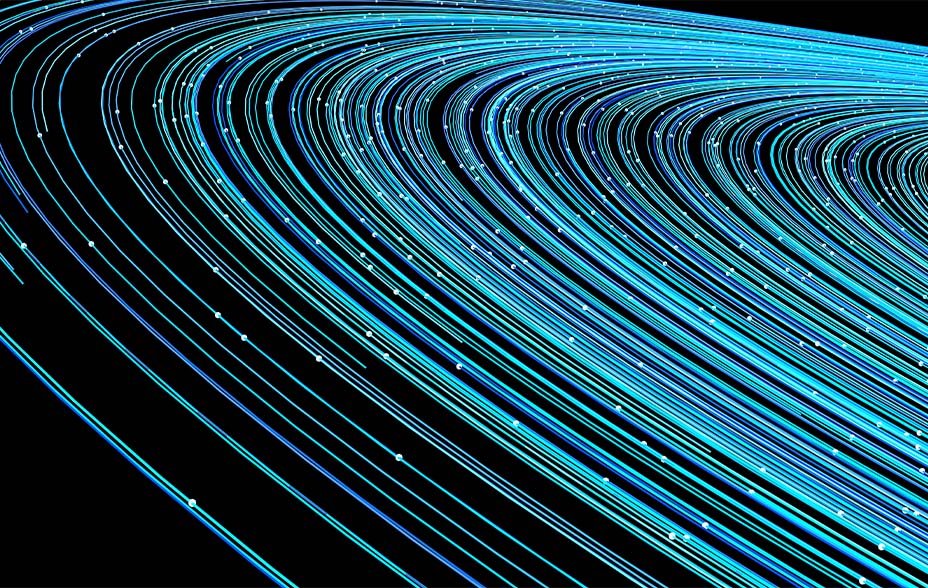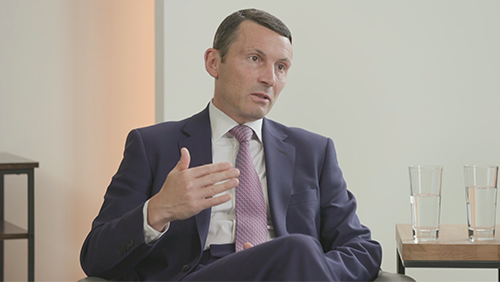May 2022
Article
Investing with Purpose
Tom Slater – Manager, Scottish Mortgage
It has been a tough year. Markets have been driven by macroeconomic concerns, geopolitics and the ongoing shockwaves from Covid-19. Investing in this environment requires resilience and clarity of purpose.

The value of shares in Scottish Mortgage, and any income from them, can fall as well as rise and investors may not get back the amount invested.
Our purpose is to provide long-term funding and support for growth companies and entrepreneurs building the future of our economy. This approach will sometimes be popular and sometimes, as now, be out of favour. Because of such swings, we discourage those with a time horizon under five years from investing in our shares. While we do not enjoy discomfiting our fellow shareholders, we believe resilience during drawdowns is necessary for generating long-term returns. We can do most to support our investee companies at times of stress.
It is more useful to observe and analyse geopolitical and macroeconomic developments than to engage in futile attempts at prediction. A standout lesson from the past two years is that our world is, in Sir John Kay’s terms, radically uncertain. We must be wary of those making confident assertions about the future. Instead, our job is to acknowledge the limits of prediction, build a portfolio that is robust to changing conditions and focus on answering the question ‘What is going on here?’
We think many of the challenges the world faces today are the negative consequences of two contentions that have driven our portfolio construction over the last decade. First, China’s economic development is disrupting the established world order. Second, technological progress has created companies of increasing geopolitical importance and a complex network of global interconnection. China’s rise has brought a vast swathe of humanity out of poverty and created opportunities for workers and investors alike. However, this success has fuelled greater geopolitical ambition and a challenge to US hegemony. Online network companies have built an infrastructure that creates economic opportunity for millions, but the scale of their impact raises questions of governance and trade-offs to limit the influence of bad actors. It will not be possible to resolve these issues quickly or easily.

China
China’s economy is now approximately three-quarters of the size of the United States (larger when measured using purchasing power parity) and a multiple of any other country. Its technology companies are world-leading in some important areas. The Made in China 2025 plan aims to make good its shortcomings in others. Indeed, by denying access to American technology, the US government forces previously ambivalent Chinese corporates to develop domestic supply chains. China’s rise has been predictable, and it telegraphs its intentions using five-year plans. The change in recent times has been the deterioration in the China-US relationship. Worsening trade relations have been matched by an increasingly hostile attitude from the US cross-party defence and foreign policy establishment, which events in Ukraine have intensified.
Investors in Chinese companies have suffered from President Xi’s regulatory crackdowns in the name of ‘common prosperity’. In retrospect, it has been a mistake to reduce our holdings in western online platform companies rather than their Chinese counterparts. The censure of Ant Group at the time of its proposed stock market listing turned out to be the first in a slew of actions that included severe constraints on the online tutoring sector, restrictions on video games, anti-monopoly activities against internet platforms and new policies on data and privacy. Many of the actions in isolation are similar to reforms that have been considered but less successfully implemented elsewhere. In aggregate, they add up to a substantial reinforcement of government control of the private sector. They have discouraged the supply of western capital.
The deteriorating geopolitical situation and significant job losses in the technology and education sectors have made the Chinese government’s aggressive regulatory stance less tenable. Vice Premier Liu He’s statement in March that the authorities should deliver ‘policies favourable to markets and be cautious in introducing contractionary measures’ may signal that the worst of the crackdown is behind us. The challenge now for western investors is twofold: incorporating the low but increased chances of future US sanctions into their evaluation of Chinese investments, and considering how the Chinese state may limit the upside in stock prices for the breakthrough winners. Our Chinese holdings have remained largely unchanged through this period of turbulence.
Technology
Technology and capital have been critical enablers of globalisation. Start-up culture has spread from its homeland on the west coast of America to the east coasts of both the US and China and then, in the mobile era, to anywhere with an internet connection. However, the providers of the capital and skills required to scale a start-up have remained relatively geographically concentrated. US venture capital companies provided financing and reaped the associated rewards from several of China’s most successful start-ups. China’s softened stance on the common prosperity policy would suggest some acknowledgement that western capital remains important. Before the war in Ukraine, globalisation was already giving way to a world of three separate economic zones (the Americas, Europe and Asia). It will be increasingly challenging for investee companies to navigate these divides.
We have little to add to the central preoccupation of markets with inflation and interest rates. Supply chains were already tight, and the combination of war in Ukraine and a substantial Covid-19 outbreak in China has exacerbated this situation. Capitalism, combined with the technical brilliance of companies such as ASML in the critical semiconductor area, will solve these supply bottlenecks over time. We believe that technological progress is not captured well in aggregate statistics and will be the primary determinant of both growth and inflation in the long term. For example, on the supply side, the production of batteries and solar panels continues to increase exponentially. While the impact on energy markets takes time to accumulate, manufacturing learning curves and ongoing technical improvements will eventually drive down energy costs. From a demand perspective, the companies we speak with that have embraced the modern tools of remote working report that their recruits are lower cost and higher quality than previously.

Portfolio
Diverse processes of significant change underpin the growth of our companies. We believe that a greater understanding of diseases’ genomic and molecular causes will result in targeted and personalised healthcare. People’s attention is shifting from traditional forms of media to online. The retail business is going mobile and payments companies are becoming aggregators of information and services. Enterprises are increasingly turning to the cloud for the provision of IT services. We are moving away from a world of carbon-based energy generation and transport. It is helpful to measure recent events and stock prices against these contentions. Has healthcare become less likely to personalise? Will people go back to offline forms of media and commerce? Are we more likely to be using fossil fuels 10 years from now?
For us, the answer to these questions is ‘No!’. Indeed, recent events are likely to have accelerated some of these processes. Consequently, we have not made meaningful changes to the portfolio. We still own all the top 30 stocks we owned a year ago (a relevant measure as approximately three-quarters of the portfolio by weight is in the top 30 holdings). Moderna, the mRNA company responsible for one of the key Covid vaccines, is now our largest holding, partly because of additions. It is the only company in our top 10 held for less than five years. We think the approach that led to its Covid vaccine will offer critical medical breakthroughs in the years to come. Tesla, the electric car producer, is our second-largest holding despite further reductions. Demand for its products far outstrips supply, and its operational execution has been remarkable.
The most significant reduction has been Amazon, our largest holding for many years. We still have enormous respect for the company and believe it has a substantial opportunity ahead of it, particularly in providing cloud infrastructure through Amazon Web Services. However, founder Jeff Bezos stepping back from the CEO role is a source of concern given how central he has been to the corporate culture. At the same time, the maths of future growth is more challenging. Ecommerce has grown from 5 per cent to 15 per cent of the US retail market over the past ten years, tripling the market for online retailers. Suppose ecommerce takes another 10 percentage points of market share over the next decade. In that case, the opportunity will only have grown by two thirds. Given our focus on growth, it now makes sense for us to redeploy capital in other areas.

Private companies
The contribution of venture investments to our portfolio and our thinking continues to grow. As in previous years, most of our new ideas come through private company investments. This year these included Solugen, a synthetic biology company seeking to produce chemicals through low-carbon processes, Redwood Materials, a battery recycling company and Capsule, an online pharmacist. Successful private investments are growing into our top holdings. We originally purchased over half of the top 30 when they were still private. At times of stress, our role in supporting younger loss-making companies becomes ever more critical. We pay careful attention to those that can deal with challenging conditions and use our capital to increase their chances of success.
As a result of our reputation as patient owners, we get the opportunity to invest in a diverse range of growth businesses. Hitherto, many of the most exciting investments have had digital business models. We are now considering more companies with physical products, which have a greater capital requirement if they are to achieve scale. Scottish Mortgage is well suited to investing in such companies, given its resources and time horizon. Our society will not transition away from carbon-based energy and transportation without substantial investment. Companies such as European battery manufacturer Northvolt will be critical to progress, and we think the returns on capital deployment can be very attractive. We are considering how we can help drive progress in this and other essential areas, including taking a more significant role in company formation.
Outlook
Most companies in the portfolio have delivered exceptional levels of growth over the past two years in a challenging operating environment. Despite geopolitical uncertainty, significant increases in the cost of living and rapidly rising interest rate expectations in many parts of the world, we are still expecting most companies to deliver high levels of growth this year. These firms are well capitalised, led by exceptional leaders and have already demonstrated high levels of adaptability and resilience. A small number of companies create the majority of stock market returns regardless of the prevailing economic conditions. We aim to identify companies with that potential and, where we find them, to support them for as long as possible.
Annual Past Performance to 31 March Each Year (Net %)
| 2018 | 2019 | 2020 | 2021 | 2022 | |
| Scottish Mortgage Investment Trust | 21.6 | 16.5 | 12.7 | 99.0 | -9.5 |
Source: Morningstar, share price, total return, sterling. Past performance is not a guide to future returns.
Risk Factors
The trust invests in overseas securities. Changes in the rates of exchange may also cause the value of your investment (and any income it may pay) to go down or up.
The trust invests in emerging markets where difficulties in dealing, settlement and custody could arise, resulting in a negative impact on the value of your investment.
The trust has significant exposure to private companies. The Trust’s risk could be increased as these assets may be more difficult to buy or sell, so changes in their prices may be greater.
About the author - Tom Slater
Manager, Scottish Mortgage
Tom Slater is manager of Scottish Mortgage. He joined Baillie Gifford in 2000 and became a partner of the firm in 2012. Tom joined the Scottish Mortgage team as deputy manager in 2009, before assuming the role of Manager in 2015. Beyond that, he is the head of the US Equities team and a member of another long-term growth equity strategy. During his time at Baillie Gifford, Tom has also worked in the Developed Asia and UK Equity teams. Tom’s investment interest is focused on high-growth companies both in listed equity markets and as an investor in private companies. He graduated BSc in Computer Science with Mathematics from the University of Edinburgh in 2000.
Important information
This communication was produced and approved at the time stated and may not have been updated subsequently. It represents views held at the time of production and may not reflect current thinking.
This content does not constitute, and is not subject to the protections afforded to, independent research. Baillie Gifford and its staff may have dealt in the investments concerned. The views expressed are not statements of fact and should not be considered as advice or a recommendation to buy, sell or hold a particular investment.
Baillie Gifford & Co and Baillie Gifford & Co Limited are authorised and regulated by the Financial Conduct Authority (FCA). The investment trusts managed by Baillie Gifford & Co Limited are listed on the London Stock Exchange and are not authorised or regulated by the FCA.
A Key Information Document is available by visiting our Documents page.
Any images used in this content are for illustrative purposes only.






